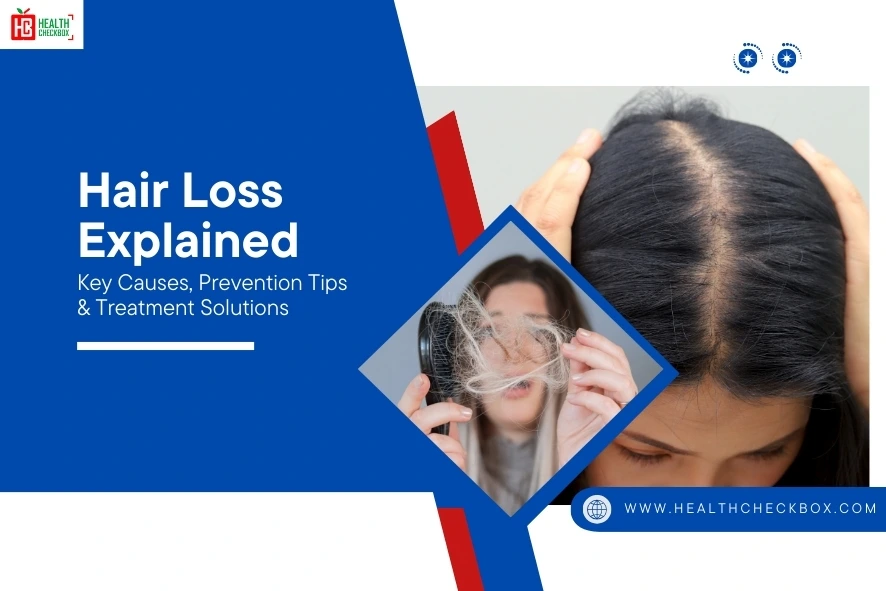Hair loss is a part of the hair growth cycle. In this cycle, old and unhealthy hair falls from your scalp, and new hair follicles grow in its place. But if you are in a situation where you see a lot of hair on your pillow in the morning. A bunch of hair in your comb, and hundreds of hair on your bathroom floor, with a bald patch and thinning of your scalp. Then this is not a part of the normal hair growth cycle. This balding and thinning is due to a condition in which your hair strands do not grow back. This condition is called alopecia. Alopecia is not cured by itself, and home-made remedies patient must consult a dermatologist. The dermatologist mainly diagnoses and provides the best solutions for your hair and scalp treatment. They prescribe treatment to cure and slow down the process of baldness.
What is Hair Loss?
Losing hair is a condition in which you lose hair from your scalp as well as other parts of your body. It depends on many factors, like your family history and hormonal changes in the body. The patient notices thinning, balding, and a receding hairline on the scalp. To know the cause and proper treatment, consult a dermatologist near you. Dermatologists manage your hair loss by providing medication, health care practices, and stress relaxation ideas.
Causes of Hair Loss
There are various reasons for hair loss. But primarily, it is caused by a combination of heredity, hormonal changes, and stress.
Genetic and Hormonal Factors
- Shifts in Hormones: Some hormonal shifts in the body at the time of pregnancy, childbirth, and menopause can trigger your hair problem.
- Family History: Male/Female baldness, also known as androgenic alopecia, is one of the common hair loss conditions caused by heredity.
- A Self-Immune Response: Autoimmune disease also causes hair problems. So hormonal shift that develops and severe the autoimmune conditions makes your hair condition worse.
Medical Condition and Treatment
- Side Effects of Medications: Certain medications for cancer, HIV, and heart disease cause hair fall as a side effect.
- Effect of Treatment and Radiation Therapy: Certain treatments for cancer, like chemotherapy and Radiation therapy, also cause this problem.
- Problem with the Immune System: Some diseases, like autoimmune in which the body eats the healthy hair follicles of your scalp, resulting in hair loss from your scalp.
Your Lifestyle and Stress Management
- Strict Hairstyle: Some strict hairstyles, like ponytails and harsh chemicals, can harm your hair and result in hair loss on your scalp.
- Nutrition Deficiency: If deficiencies of vitamins and nutrients, like Iron, occur in your body, then it increases your hair loss.
- Stress-Related Problem: Stress-related problem causes thinning and shedding of hair from your scalp.
Symptoms of Hair Loss
Every individual experiences different symptoms depending on the cause and type of hair loss they experience. Some of the common symptoms of hair loss are:
- Receding of your Hairline: In this process, your hairline moves back from your temples, in an M shape, and thinning hair grows on the top of your head.
- Problem of Hair Thinning: Weakening of hair occurs all over the scalp, which is especially caused by hormonal changes, genetics, and other factors.
- Loss of Hair in Patches: In this condition, hair loss occurs in patches from specific areas of your scalp and body.
- More Hair Shedding: If you lose more hair than normal in the recent few months or years, then it is also a symptom of hair loss.
- Itching of the Scalp: If you have a problem related to your scalp skin, then it causes itching and pain in the affected areas of the skin.
Types of Hair Loss
According to the dermatologist, types of hair loss are :
- Androgenic Alopecia: It is also known as male pattern hair loss, mainly caused by heredity, and affects both men and women.
- Alopecia Areata: This condition happens due to an autoimmune disease and results in hair loss from your scalp and body in patches.
- Telogen effluvium: This type of hair loss occurs suddenly for a short period of time due to some physical and mental stress. Normally condition of telogen effluvium is temporary.
- Anagen effluvium: Hair loss occurs due to certain medications, surgery, and cancer is called anagen effluvium. Normally, this type of hair loss is very rapid and temporary, and your hair can regrow after the treatment.
How to Prevent Hair Loss?
You can not prevent a permanent hair problem, even big celebrities become bald after their 40s. But you can reduce the process of losing hair by keeping your hair healthy. To minimize this problem, dermatologists provide these techniques:
- Healthy Diet: Prefer a healthy diet for the prevention of hair loss with an adequate amount of calories, protein, and iron. Include foods in your diet which is rich in vitamins and minerals is good for your hair.
- Lifestyle and Stress Management Techniques: The Doctor advises doing exercise regularly, applying scalp massage, and stress management to improve your hair texture and strength.
- Styling Techniques and Hair Care: Dermatologists advise patients to take certain precautions during their styling and hair care routine to prevent hair follicles from harm. These precautions are to use shampoo and conditioners that suit your hair type. Don’t use harmful chemicals that harm hair follicles.
Diagnosis and Test
A dermatologist diagnoses your hair problem by doing a physical examination of your skin, certain body tests, and other hormonal imbalance checkups. A deep checkup is done by techniques like scalp biopsy, skin scraping, to check your health of the scalp skin. To check your hair and scalp health doctor takes the following steps:
- Check your Family History: Dermatologists ask that you have any family history of baldness on your maternal or father side.
- Examine your Medical History: Doctor, check your medical history to know the exact problem.
- Physical Examination: The Doctor physically examines your hair pattern, infection, and inflammation of the skin to check for any skin and genetic issues.
- Pull Test of Hair: A small bundle of hair follicles is pulled out by a dermatologist to check the strength of the hair.
- Blood Test: A Blood test is done by doctors to check for any deficiencies in the body, thyroid-related problems, and other hormonal imbalances in your body.
- Scalp Biospy: In the scalp biopsy doctor removes a small part of your scalp skin to check for any skin-related disease.
- Scraping of Skin: If a patient shows symptoms of scaling and irritation. Then, a dermatologist collects their skin scraping to examine any fungal or other infections.
Management and Treatment Options for Hair Loss
Dermatologists provide various management and treatment options for hair problems, including advanced surgical procedures like hair transplantation, drugs, and therapy. But management and treatment of hair loss can be varied and depend on many factors, like the stage of hair loss, severity, age, and the treatment choice of an individual. Dermatologists provide the following options for the treatment of hair loss according to your needs:
Non-surgical treatment
Non-surgical treatment is the best option for people who have the early stage of hair loss. This treatment involves various medications like minoxidil, finasteride, which slow down the process of thinning and promote new hair growth.
- Tropical solution(Minoxidil): Minoxidil is generally prescribed by the dermatologist for hair problem treatment. This is the best over-the-counter vasodilator that is applied directly to the scalp to increase the blood flow around the follicles. Minoxidil slows down the loss of hair and promotes the growth of new hair follicles.
- Ketaconazole Shampoo: Ketaconazole is generally prescribed by doctors to reduce the scaling and inflammation caused by fungal infections, such as seborrheic dermatitis. This infection is the main cause of hair problems in some people.
- Oral Medications(Finasteride): Finasteride is primarily developed to treat an enlarged prostate. But the doctor noticed it’s some secondary effects, like slowing down the hair loss and promoting new hair growth in most people. So the dermatologist now prescribed its lower dose for the treatment of Balding. This FDA-approved drug mainly blocks the DHT, which is the main cause of hair problems in male pattern baldness.
Surgical Treatment
Surgical Treatment is the best option for a patient who has stage 5 balding. Stage 5 patients are partially bald and have hair only on the back and sides of the head. In this treatment, doctors remove hair from the donor side and transfer it to the recipient side(bald area). These treatment mainly involves the following two techniques:
- Follicular Unit Transplantation (FUT): In these techniques doctor removes a strip of skin from your donor area. And they divide it into follicular units for transplant. This method is effective for people who have a large bald area.
- Follicular Unit Extraction (FUE): In the FUE technique doctor extracts individual hair follicles from the donor area. They extract one by one and implant them into the recipient area of the scalp.
Conclusion
The condition of hair loss can be permanent or temporary. But this condition can be affected by many factors, like family history, hormones, nutritional deficiency, and lifestyle. It is important to know the signs of losing hair. Its underlying causes are addressed at the right time to prevent hair loss. So that by taking the consultations from a dermatologist, you can take an effective treatment and management for hair problems. I hope this article helps you to understand the symptoms and causes of hair loss.

